#vinegeekapproved #vinegeek

on Instagram: http://instagr.am/p/WIwARPM55k/
#vinegeekapproved #vinegeek

on Instagram: http://instagr.am/p/WIwARPM55k/
Have you head of the new “Locations” project from Dave Phinney (of Orin Swift)? I hadn’t until recently. He’s sourcing the wine from sites across France and blending them together:
2011 is the first vintage of our French red wine sourced from some of the finest locations throughout France. Grenache from the Roussillon, Syrah from the Rhone, and assorted Bordeaux varietals are sensibly blended in an original style that showcases the best of what this historic land has to offer. During months of travel throughout storied growing appellations, winemaker Dave Phinney was able to secure prized vineyard sites to realize his objective. Utilizing a carte blanche approach and forgoing tradition, a powerful and balanced wine emerged that justly pays homage to the country of France.
In addition to this Franc-enstein bottling, he’s done one from Spain (Spain-kenstein?) that blends across Priorat, Rioja and Ribera del Duero. Another from Italy is in the works.
This offends my sensibilities on several levels.
That said, I got a chance to taste the French version and I actually kind of enjoyed what was in the glass. Go ahead and call me a snob, but just because it tastes good, doesn’t mean I have to like it.

Apparently, I’m a year or two late to this, but HOLY SHIT, did you know Nicholas Felton designed some wine labels! How did I miss this?
Nicholas Felton is a star in the world of data visualization. His Feltron Reports (each a data-driven record of his year, done in the style of a corporate annual report) are legendary. He also cofounded Daytum and inspired the Facebook Timeline. As a data geek, both professionally and personally, I love his stuff. Which is why I can’t believe I never heard of this. If there are two things that always catch my eye on Twitter, it’s talk of data visualization/infographics and wine labels.
Alright, enough of my dismay over missing this news. Let’s take a look at the labels. They were done for Between Five Bells, a small winery in Victoria, Australia. You can read their story of the labels here. There are two general label styles: one style is focused on the vinification data and the other style is focused on the growing season or vintage data. Let’s start with the first.
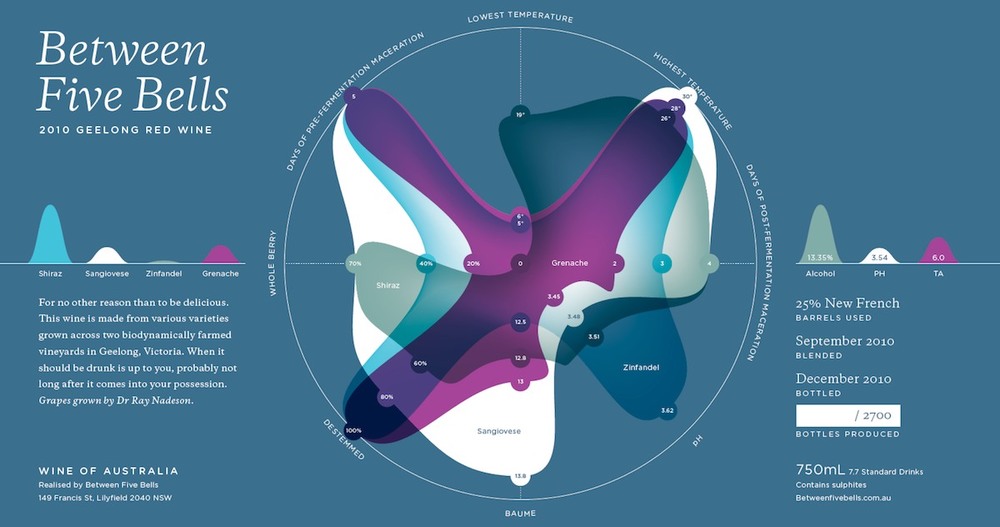
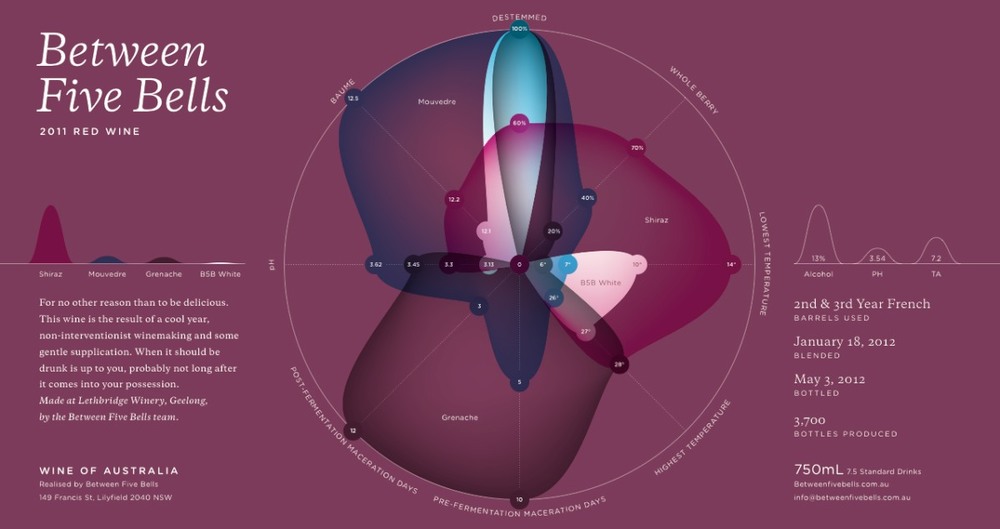
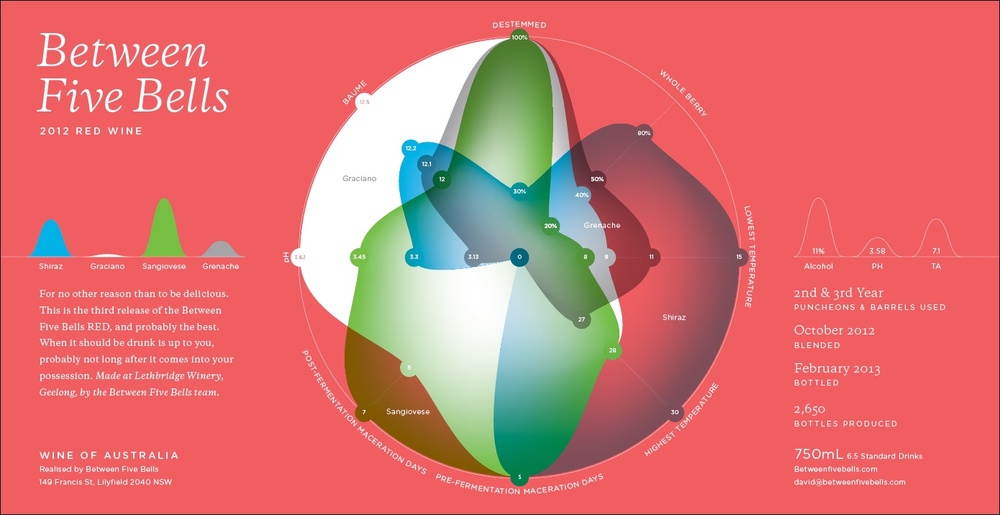
The main visual on each of these labels shows eight key data points for each grape variety in the blend: from baume and pH to whole cluster and de-stemmed percentages to maceration days and fermentation temperatures. That’s a lot of data and it makes for a unique and cool signature of each wine, almost like a thumbprint.
Two quibbles. 1) In the little chart on the left that presumably shows the proportions of each grape variety in the final blend, why not include the actual percentage values? The data labels are shown for every other data point on the label and the average wine drinker cares way more about this information than all the rest. 2) As a Mourvèdre evangelist, I cringe a bit at the spelling “Mouvedre” on the 2011 label.
But very cool labels, indeed.
•••
Next up are the Rosé labels, which focus on the growing season data.
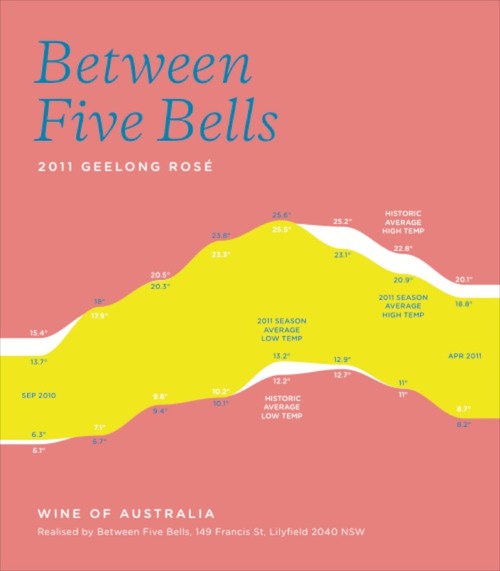
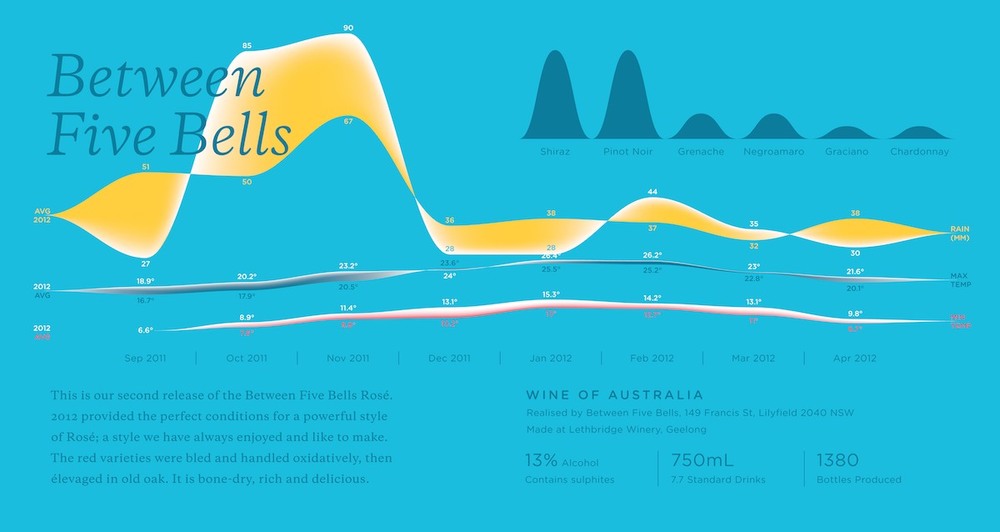
The Rosé labels take a different approach. I wonder if it was driven by the difficulty of employing the other style with seven grape varieties instead of just four. These two are more different from each other than labels in the other style are, so let’s take them one at a time.
The front label of the 2011 shows the historic average high and low temperatures across the growing season (September to April) — that’s the white band. The yellow band overlays the average high and low temperatures for the 2011 vintage. You can see at a glance that this vintage was a cool one, especially in the last several months of the growing season. The back label (not shown here) displays the rainfall vs. the historic average in a similar fashion.
With the 2012 label, they decided to “stack” these charts, which makes some sense given that they are on the same time scale. Also the high and low values are not shown as a band; rather, each is is plotted as a ribbon, with the deviation (positive or negative) from the average filled in. I find the 2012 more confusing than the 2011. To my eyes & brain, it’s harder to tell from a quick look at the high and low temperature ribbons when they are above or below the historic average. This is easier on the rainfall ribbon, which is very cool and has the unique signature effect.
I really love the 2011 Rosé label. Even beyond the data, I think it works really well as a wine label. Because it’s trying to do less, it’s cleaner and there are fewer axis labels and such, which makes it possible to see it as label art first and chart second. Also, bonus points for it fitting on a single front label, not a wraparound label. As a blogger who frequently photographs labels for posts or Instagram, wraparound labels are a pain in the neck. I also love that it speaks to the wine’s place more than the winemaking style. Now if they could just add those grape variety percentages and maybe add soil composition, vine age…
•••
You may be wondering, what finally tipped me off to this. Instagram, of all things. I saw a photo from @hawk_wakawaka that mentioned this winery. Intrigued by the unusual blend she mentioned (cool-climate Shiraz, Sangiovese, Grenache and Zinfandel in Australia), I googled them only to have my day made by their labels. Better late than never.
Read Eric Asimov’s article on Antonio Galloni leaving The Wine Advocate to start his own online property “aimed at younger wine consumers.” I wish him well. My favorite quote:
 I have this vision of going to a restaurant and seeing a bottle of wine on every table. Everything I want to do is centered on how do I make that happen, how can I help people make these choices.
I have this vision of going to a restaurant and seeing a bottle of wine on every table. Everything I want to do is centered on how do I make that happen, how can I help people make these choices.— Antonio Galloni, on his new direction upon leaving The Wine Advocate
#mourvedremonday #vinegeekapproved #vinegeek #lastbottleblues 
on Instagram: http://instagr.am/p/VnSctPM5_Z/
Inventor Adrian Cheok, profiled by Eliza Strickland at IEEE Spectrum, is “dedicated to building multisensory communication gadgets.” After building little haptic jackets for pet chickens (!), he’s setting his sites higher:
 Cheok has a “digital lollipop” in the works that electrically and thermally stimulates the tongue to produce basic flavors—bitter, sour, salty, sweet. He dreams of a system that would let friends in Paris send you a taste of their wine over the Internet. “The ultimate Internet,” he says, “will integrate all our senses.”
Cheok has a “digital lollipop” in the works that electrically and thermally stimulates the tongue to produce basic flavors—bitter, sour, salty, sweet. He dreams of a system that would let friends in Paris send you a taste of their wine over the Internet. “The ultimate Internet,” he says, “will integrate all our senses.”This will never really work for wine, right? So much of the “flavor” of wine is olfactory. Stimulating the tongue couldn’t communicate even 1/10 of the real experience of drinking a particular wine.
It is nice to imagine Mourvèdre lollipops, though.
Wow! just ate a lamb's spinal cord and washed it down with #Bandol @TheMarrowNYC happy BDay to me.
— John-Paul Quattrone (@jaypeeq) January 30, 2013
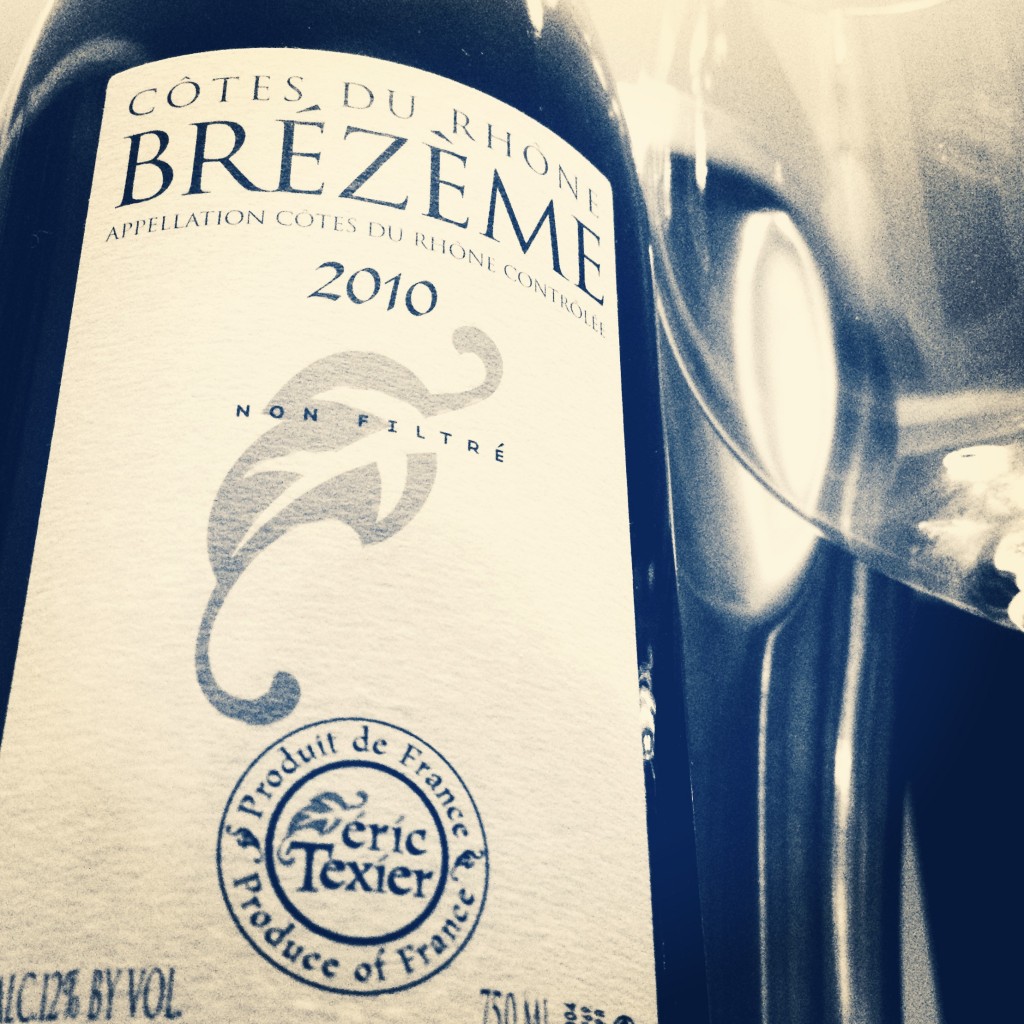
That was the phrase that immediately leapt to mind when I first tasted this wine. And it stayed stuck in my brain with every subsequent sip. So I’m just gonna leave it at that. I really loved this wine. If you dig vin natural and/or cool-climate syrah, definitely check this out.
— – —
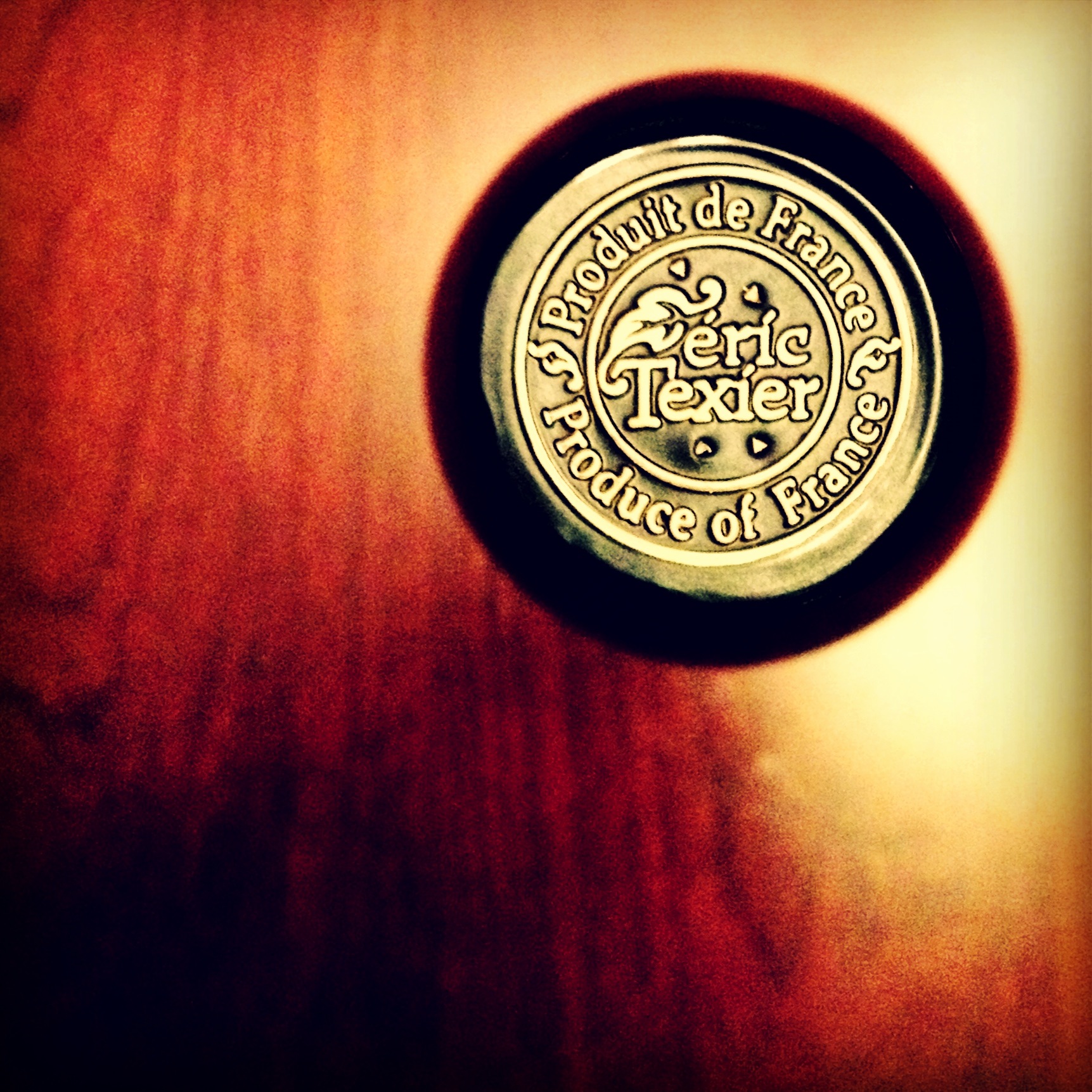
Producer: Eric Texier
Grapes: 100% Syrah
Appellation: Côtes du Rhône – Brézème
Vineyard: Brézème — Estate vineyard on a southwest-facing slope. Rocky limestone & clay soil. Vines average 15 years in age. (More details from winery.)
Vintage: 2010
Winemaking: Indigenous yeast fermentation. Neutral oak élevage. Non filtré.
Alcohol: 12%
Price: $24
It’s been quite a while since I’ve had a chance to taste a Barossa Mourvèdre for the intermittent yet persistent #MourvedreMonday series. I recently came across this bottle at a wine shop I hadn’t visited before. I’d heard of Turkey Flat before via my Mourvèdre-radar (i.e., hours on the internet), but hadn’t ever found a bottle on the shelf. So I was happy to find this one, with bonus points for a little bottle age.
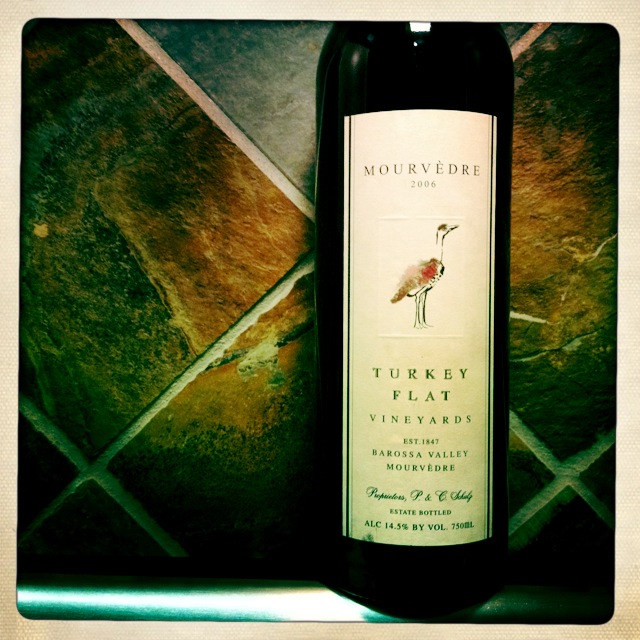
Producer: Turkey Flat Vineyards
Grapes: 100% Mourvèdre
Appellation: Barossa Valley (Australia)
Vineyard: Turkey Flat Stonewell Block, a dry-farmed estate vineyard with limestone soil
Vintage: 2006
Winemaking: 20 months in new & seasoned French oak puncheons
Alcohol: 14.5%
Price: $32
My tasting notes: Deep, dark color. A bright raspberry note dominates the nose, but there’s an earthy complexity as well. It’s rich and full on the palate, with lifted red and black fruit that stays grounded by a sense of leather and spice. A bit of toasty oak. It finishes dry and grippy.
Overall impression: A nice spicy Barossa Mourvèdre that I’d happily drink again. This wine’s certainly no turkey. I hope to track down some other vintages of this wine and/or Turkey Flat’s GSM called Butchers Block Red.